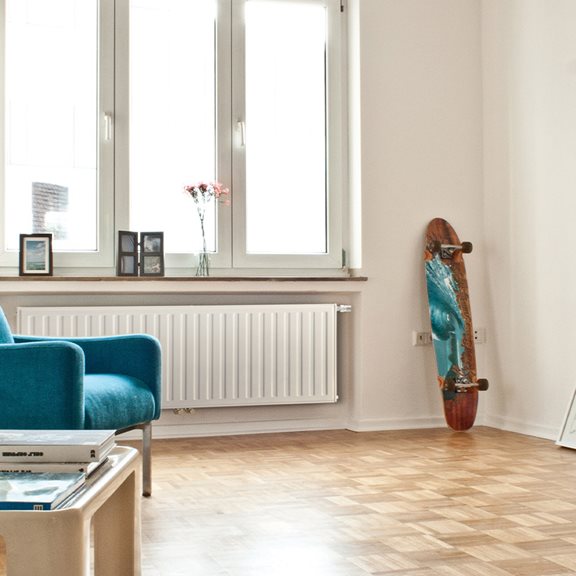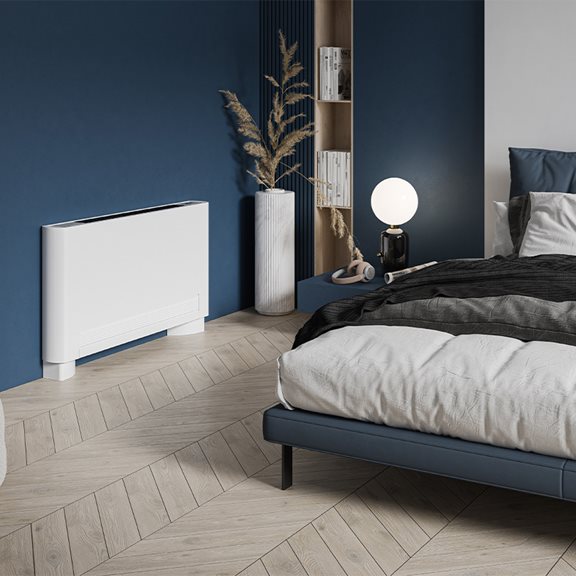How to bleed a radiator
Find out why, when and how to bleed a radiator correctly, the different steps to follow and the equipment you will need.
How do you bleed a radiator?
First of all, what exactly does bleeding a radiator involve? The dictionary gives us this definition: to bleed a radiator is ‘to remove any air that may be present when a liquid is circulating through it’. Why, when, how and with what equipment? Here’s everything you ever wanted to know about the subject
Why bleed your radiators?
The presence of air in pipes and radiators is detrimental to the proper operation of your heating system. In several different ways, this air can negatively affect your comfort and your wallet.
A less efficient heating system
Air bubbles seeping into your heating system simply prevent the proper circulation of water around your pipes and radiators. Consequently, radiators heat up too slowly, only partially, or remain completely cold.
Higher energy costs
To reach the desired temperature you have set on your room thermostat or via the thermostatic valves on your radiators, your boiler has to run harder and longer. This results in much higher energy consumption.
Rust formation
Finally, the air in your heating system contains oxygen. This can cause corrosion of the pipes of your heating system, i.e. the appearance of rust which can in turn cause leaks. You will then have to have the affected pipes or radiators repaired or even replaced. You can easily avoid these costs, sometimes expensive, by remembering to bleed your radiators regularly.
When should you bleed the radiators? And who should do it?
First question: how do you know if you need to bleed a radiator? The answer is simple: when your radiators make strange rumbling, gurgling and other whistling sounds, this indicates that they contain air. Another clue: if they are clearly having difficulty increasing in temperature, or they remain warm or cold, it is time to bleed your radiators.
<H3> The best time to bleed a radiator
You don’t necessarily have to wait until your radiators need to be bled, to bleed them. You can decide to bleed them systematically every year, ideally right after your boiler has been serviced. This maintenance is best planned at the end of the summer, when your heating engineer is not yet overbooked. Moreover, although you can perfectly well do it yourself, you can ask him to do this bleed while busy on the overall maintenance of your boiler.
How do you bleed your radiators correctly?
As mentioned above, you can easily bleed your radiators yourself. It will only take you a few minutes per radiator (five minutes at most) and you won’t run any risk if you follow the different steps that we describe below.
Before you start bleeding your radiators
First, identify the radiator(s) to be bled. How do you spot those that contain air mixed with the water in your heating system? The bottom of the radiator will be warm, while the top remains cold. You can also decide to bleed all the radiators, so you don’t have to do them one by one. Then, follow these steps:
- Open the (thermostatic) valves on all your radiators and increase the temperature on your thermostat to run your boiler at full capacity for 15 minutes.
- After this time, set the thermostat to the lowest temperature in order to turn off the boiler. This will stop the heating circulation pump, and it will prevent water and air from circulating through your pipes.
- Wait for about 15 minutes for your radiators to cool down completely. It is important to bleed them cold, to prevent splashes of hot water from burning you.
- In the meantime, gather the materials you need, namely:
- A bleed key to open the bleed valve (a flat screwdriver can also be used in some cases, depending on the configuration of the valve);
- A container to collect the water that flows from the radiator;
- A cloth or towel to protect the floor and wall, and to soak up any water splashes.
Bleeding the radiators
Before going through the different steps to follow when bleeding a radiator, a question arises: in what order should radiators be bled? In other words, which radiator and/or floor should be bled first? As the air moves from the bottom to the top, you should follow the same upward movement. In other words, start with the radiator located closest to the boiler. You should start with the lowest floor and end with the highest.
Let us now begin the key phase, the bleed itself:
- Locate the bleed valve: it looks like a small round hole surrounding a square, and is usually located at the top of the radiator, opposite the valve/tap.
- Place your tea towel against the wall and on the floor under the radiator, on the bleed valve side, to protect them from water splashes.
- Holding your container under the bleed valve with one hand, insert the bleed key (or screwdriver) into the bleed valve and slowly turn it to the left. A quarter or half turn is enough: you will immediately hear the air escaping with a whistling sound. Caution: do not open the bleed valve further, otherwise you may not be able to close it completely.
- Is water leaking from the bleed valve? This is a sign that all the air h as been released from your radiator and that it is fully bled. You can then close the bleed valve by turning the key to the right, without tightening it too much. Do this without delay to avoid too much water flow – the aim is not to completely empty your heating system of its water!
- Proceed in the same way to bleed your other radiators.
After the bleed
Are you done? You can now turn your boiler back on. Check the water pressure of the heating system: it should be between 1.5 and 2 bars. Is the pressure too weak? Add water to your heating system, until you reach the required pressure.
After an hour, check if all your radiators are heating properly and evenly. If necessary, carry out a second bleed on any radiators that are not operating correctly.
Still have a problem?
Are your radiators still not working well, even after bleeding them a second time? The problem may be due to a leak, or damage to one of the pipes or expansion tank. To adjust it, don’t hesitate to call on your heating engineer, who will ensure your home is well-heated and comfortable again.
Book an appointment for bespoke advice!
Our experts are here to help you make the best choices.
Keep up to date
News, trends and special offers...
Subscribe to our monthly newsletter


.jpg?width=576)
